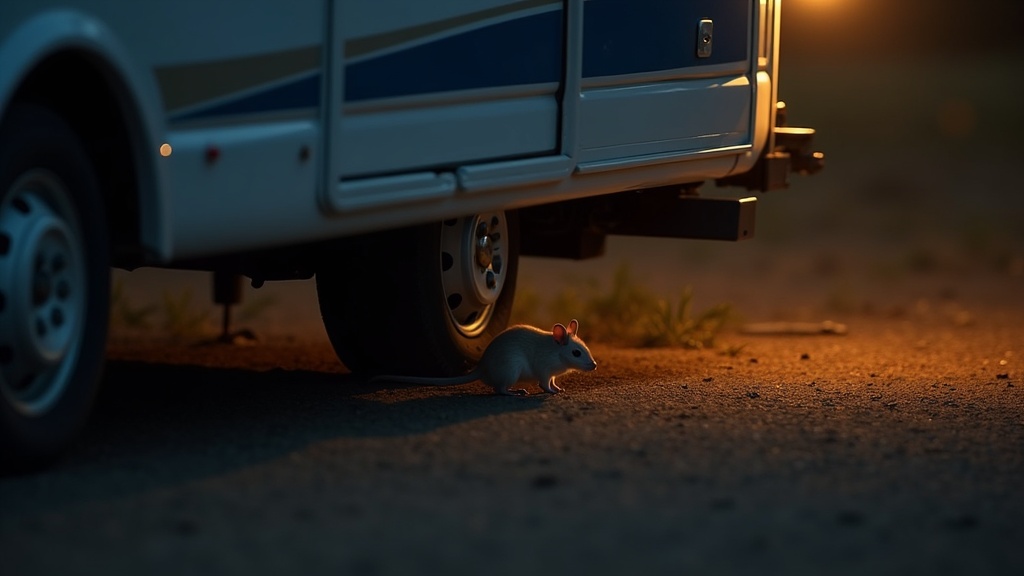Mice in your RV are more than just a nuisance. They can quickly cause damage, leave behind messes, and make your rolling home feel a lot less comfortable. I’ve personally run into this issue on more than one road trip. After a few encounters with unwelcome furry visitors, I’ve picked up quite a bit about getting rid of mice in an RV, and keeping them from ever coming back. Here’s my all-in-one guide on how to show mice the door and keep your RV ready for the next adventure, rodent-free.

Why Mice Love RVs (And Why You’ll Want to Act Fast)
RVs really are a paradise for mice. They’re warm, filled with little hiding spots, and best of all, food is often left behind even when you think your rig is spick-and-span. Mice can squeeze into jaw-droppingly tiny holes (about the size of a pencil eraser), and once inside, they’ll chew wires, gnaw on upholstery, and make nests out of anything soft they can scrounge up.
Acting quickly makes a big difference because just a couple mice can have a full extended family (dozens of babies!) in only a few weeks. The longer you delay, the larger and messier the problem will be. Besides property damage, mice droppings and urine can bring on health risks, like respiratory issues or allergies, so it’s important not to put this on the back burner.
How to Spot Mice in Your RV
While you might spot a critter darting behind a cabinet, that’s usually not the first sign you notice. Mice can be sneaky, so here’s what I always keep an eye out for when looking for an infestation:
- Droppings: These resemble small, dark grains of rice—usually found near food, under sinks, or in drawers.
- Chewed food packaging: Any unexplained holes in food bags, cardboard, or plastic are big red flags.
- Shredded nesting material: Bits of paper, fabric, or insulation gathered in corners almost always mean mice are building a home.
- Noises: Listen out for scratching, squeaking, or scurrying, especially at night.
- Musky odor: A strong, musty smell can give away a bigger mouse colony nearby.
Step-by-Step Guide: Getting Rid of Mice in Your RV
I’ve split the process into easy-to-follow steps. This is how I personally handle a mouse problem: thoroughly, so I’m not always playing catch-up.
1. Get Rid of Any Mice Already Inside
- Set snap traps or electronic traps: I avoid poison because dead mice in hidden spots cause serious odors and headaches. Snap traps and electronic traps get the job done fast, and they show where mice are making their way in.
- Use tasty bait: Peanut butter, chocolate, and seeds rarely fail. If you’re not catching much, swap baits to see what works best.
- Place traps along walls: Mice hug the edges of rooms, rarely crossing open floors. Setting traps where they travel bumps up your odds.
- Check and reset traps regularly: It’s a must to check at least once or twice a day and reset as needed.
2. Seal the Gaps (Otherwise, They’ll Be Back)
Mice can squeeze into holes as small as 1/4 inch. I always get down on the floor inside and outside with a flashlight to hunt for any opening. The most common gaps show up:
- Around plumbing and electrical wires
- By slideouts and vents
- Beneath doors and storage compartments
Plug small holes with steel wool and finish off with caulking or expanding foam. Big gaps call for metal mesh and weatherstripping. This one step alone stops most future invasions in their tracks.
3. Clean Up and Eliminate Mouse Attractants
- Store all food in airtight containers: I put cereal, pasta, and pet food in hard plastic or glass. Mice tear through paper and even thin plastic like it’s nothing.
- Take out the garbage regularly: Don’t leave full trash bags overnight—they scream “All you can eat” to mice.
- Wipe counters and sweep every day: Little crumbs and food bits pile up super quickly in a small RV, so a daily pass makes a difference.
- Fix any leaks: Even a tiny drip makes your RV even more inviting by providing water as well as shelter.
What to Use: Traps, Repellents, and Other Options
There’s a ton of gear claiming to repel or catch mice. Here’s what’s honestly worked for me, along with a few letdowns:
- Snap traps: Fast, affordable, and they just plain work. Set a bunch for best results.
- Electronic traps: Zap mice instantly. Good for small spaces, simple to clean, and can be reused over and over.
- Live traps: Go for these if you want to avoid killing mice. Just remember to release mice far away or they’ll be right back.
- Ultrasonic repellents: The verdict is out. Some say they work wonders, but I only use them as backup.
- Natural deterrents: Peppermint oil on cotton balls and repellent sachets help deter mice but alone won’t handle a real invasion. Ideal to use as a finishing touch after you’ve handled the main problem.
- Poison: Personally, I always skip poison. A dead mouse hidden in the walls is far worse than seeing one alive under your sink.
Mice Prevention: Keeping Your RV Mouse-Free All Year
After you’ve cleared out your current visitors, prevention really makes a world of difference for a hassle-free, mouse-free RV lifestyle. Some of my favorite tricks for keeping rodents away:
- Check for gaps every season: RVs move and flex a bunch, so new holes show up over time.
- Don’t feed pets outside your RV: Leftover kibble is like a mouse magnet.
- Remove birdseed, pet food, and grass seed from storage: Anything edible is fair game for mice. Keep it out or in rodent-proof totes.
- Stay tidy and organized: Towels, rags, and spare paper products can be perfect nesting materials if stashed and forgotten.
- Try natural deterrents before storing your RV: Peppermint oil, commercial mouse deterrent pouches, or dryer sheets can all add some extra protection.
Common Challenges (And How to Handle Them)
When you’re up against mice in an RV, a few stumbling blocks might crop up. Here are the ones I see most, and my best tips for getting through them.
Dealing With Persistent Mice
If mice won’t quit, go over your RV for hidden entry spots. Sometimes the gaps are behind a panel or inside a storage bay. A flashlight, mirror, and a little flour (to catch footprints) can help. Set more traps if you keep catching mice—sometimes it takes a full-court press to win the battle.
Odor and Cleanup
Mouse droppings and urine often leave behind a strong odor. Scrub with a good disinfectant (bleach and water mix is tough to beat), and don’t forget gloves and a mask since sweeping can send dust airborne. Throw out any fabric or paper they’ve nested in, and run any affected bedding or towels through the wash for safety.
Avoiding Mice During Parking and Storage
When your RV is parked for weeks or months, here’s what I do to keep mice at bay:
- Take out all food (even dry goods and treats for pets)
- Keep windows, vents, and doors sealed tight
- Double-check storage bays for any missed entry points
- Refresh repellents and traps every couple of weeks
Frequently Asked Questions
Below are a handful of questions I had during my first run-in with RV mice, plus some wisdom I’ve gained:
Question: What’s the quickest way to kick mice out of my RV?
Answer: Snap traps baited with peanut butter tend to catch mice quickly. Set them along walls and in corners for fastest results.
Question: Can peppermint oil really keep mice out?
Answer: Peppermint oil is a good deterrent for keeping mice away, but it usually isn’t enough to end an active infestation. It shines as a prevention tool once you’ve sealed up any holes and handled the existing rodents.
Question: How do I keep mice away when storing my RV in winter?
Answer: Clear out all food, plug every gap you find, place backup traps, and use repellents or scented pouches. It helps to check in periodically, instead of waiting until spring to do your first inspection.
Question: Are any high-tech mouse deterrents worth the money?
Answer: Some swear by ultrasonic deterrents, but my experience is lukewarm. They’re best as an extra boost, not a primary tool. Traps and real physical barriers make a bigger impact.
Products and Quick DIY Fixes Worth Trying
Mice invasions have forced me to get creative and try a whole bunch of options. These picks really pulled their weight:
- Steel wool and foam sealant: Handy for plugging gaps on the spot
- Plastic bins with good lids: Perfect for stashing snacks, pet food, or seeds—mice can’t chew through these easily
- Snap and electronic traps: Always keep extras ready for new trouble
- Homemade peppermint spray: Mix peppermint oil with water and spray near all likely entry spots or places with mouse activity
Routine inspections and tidy habits go a long way. Reading other RVers’ reviews and adjusting your game plan helps you find what meshes best with your specific setup and travel style. Stock up on traps, sealant, and some peppermint oil—you’ll be glad you did.
The bottom line? If you stay persistent, use common sense, and do a little maintenance, you’ll have a mouse-free RV all year. That means more time to soak up the great outdoors, and less time stressed about pesky stowaways.
